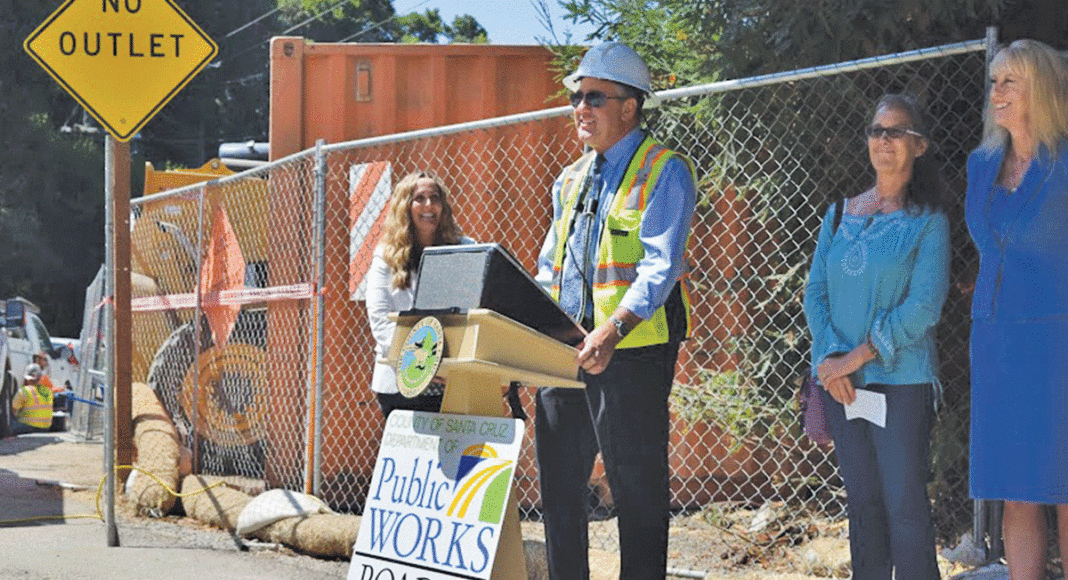Danny Keith will not forget the half-dozen close calls he had with coyotes and deer as his car snaked down the mountains after Valencia Road closed. For seven-and-half months, he and at least a thousand neighbors in Aptos used a windy, rural detour to go home after winter storms wiped out his normal route.
“It was usually at dusk. The road just wasn’t built to handle a thousand cars going up it everyday,” Keith says. “The back-country blind turns weren’t always predictable.”
Valencia, an arterial road of Aptos, opened this month after a culvert collapsed last winter, forcing several hundred families to use an indirect route for errands and school.
While the neighborhood celebrated a temporary bridge opening on Monday, Aug. 7, the county expects full repairs from last year’s storms to take years.
“We were the worst hit county in California,” says Public Works Director John Presleigh. “We’ve seen bad years before, in ’95 and ’82. But this was particularly bad.”
Closures impacted an incredible number of roads at one time, with storms causing major and repeated impacts on thoroughfares like Soquel San Jose Road and Highways 7, 9, 35 and 152. A major sinkhole on Nelson Road was fixed—temporarily, at least—by Public Works tying two flatbed railroad cars together.
The damage will cost $129 million across 320 locations, paid for with the help of federal funds. Public Works created an internal Recovery Unit that aims to fix 90 percent of the torn-up infrastructure within five years. Monterey County was hit with $60 million worth of damages.
The Valencia project alone cost $4 million. Like other repairs, the county has applied for federal disaster aid to fund them, expecting to pay at least $25 million of the total itself over five years.
Presleigh’s office is hiring five new design consultants on top of the county’s four project designers. Nearly all of the county’s paperwork for the repairs is in, Presleigh says, with action pending from federal and state agencies.
Some Valencia Road residents have complained about the delays. Presleigh says the repair bypassed standard Caltrans protocols after a concerted effort to install the temporary fix.
Presleigh lobbied for quicker Caltrans approval in Sacramento, since the state agency is allowed to do emergency openings, while Rep. Jimmy Panetta and Rep. Anna Eshoo spoke with the Federal Highway Administration on the federal level.
But it was a group of schoolkids who helped moved the needle. They were cut off from Valencia Elementary School, and were sent to Mar Vista Elementary School, Cabrillo College, Aptos High School and Rolling Hills Middle School instead.
“I think Caltrans woke up when they got letters from the kids,” Presleigh says, adding that Supervisors Zach Friend, Bruce McPherson and John Leopold also assisted.
Meanwhile, major arteries like Soquel Drive going into Aptos Village, and dozens of smaller rural roads, are in need of repair. Construction has started on just 9 percent of the 98 Federal Highway Administration projects and 15 percent of FEMA projects. The completion rate is about half that.
There are two types of roads the county is working on: big, arterial roads that Caltrans and the Federal Highway Administration can assist with, and smaller residential roads in the mountains, which are local roads with repairs potentially funded through California’s Office of Emergency Services and FEMA.
Public Works is coordinating with those agencies to determine which should be fixed first. Measure D is being used to cover the county’s portion of the smaller, FEMA road costs. Other costs are being covered by the Federal Highway Administration and California’s Office of Emergency Services.
Presleigh said the county was “starved for resources” before SB 1 and Measure D passed, and intended to use the funds for county road resurfacing. Now, it’s stuck doing storm repair again.
“We still want to do a progressive pavement plan,” Presleigh said. “But we’re going to have to get creative on spending money.”
At a supervisors’ meeting this month, Leopold asked Presleigh to report back in October on if the county could reduce its overhead costs to leverage more federal money.
“If you look at that report, the local match was something like $18.5 million—and there was a magic asterisk next to it that said, ‘Depending on overhead cost.’ We need to reduce those so we can get projects up and going as quickly as possible,” Leopold said.
Presleigh says that may be possible, given the large number of projects; the percentage could drop from 12.5 to 10 percent or so. His department will present more information to the supes in September.
Meanwhile, Rolling Greens, the community affected by the Valencia closure, has become closer because of the storms, Keith said. Many joined the social network Nextdoor and offered to pick up supplies in town. A yard sale is planned on Aug. 27 to bring people into the neighborhood, and some community members revived an inactive neighborhood improvement association.
Lisa Woolnick, whose son was in sixth grade at Valencia when the storms closed the school, was elected president of the association in their aftermath. She’s helping plan a community party later this month, with elected officials and Public Works staff invited.
“My kid always walked to school. We had no way to get there, so we formed carpools,” Woolnick said. “Through this, we’ve become stronger.”













